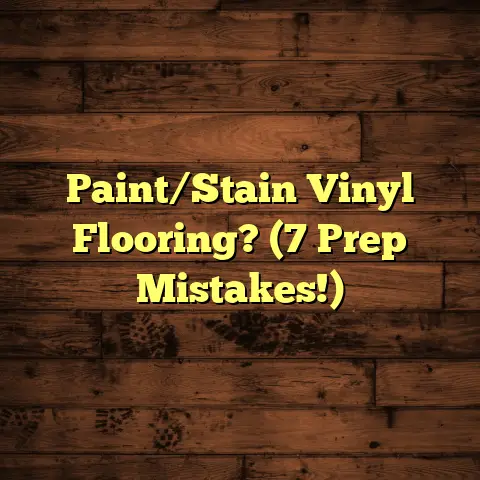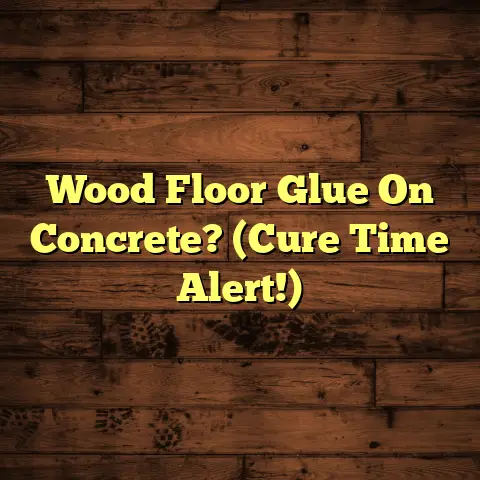Engineered Flooring Waterproof? (The Shocking Truth!)
Did you know that nearly half of homeowners believe all engineered flooring is fully waterproof?
That’s a recipe for disaster, right?
I’ve seen it happen, and trust me, the aftermath is never pretty.
I’m here to set the record straight.
Let’s dive deep into the world of engineered flooring, separating fact from fiction.
I’ll share my experiences, industry secrets, and the cold, hard truth about whether that beautiful floor you’re eyeing can really handle spills and splashes.
Section 1: Understanding Engineered Flooring
1. Definition and Composition: What is Engineered Flooring?
Okay, let’s break it down.
Engineered flooring isn’t just one solid piece of wood.
Think of it like a multi-layered cake, but instead of frosting, we have wood!
Typically, you’ve got a top layer (the veneer), a core, and a backing.
- Top Veneer: This is the star of the show – a thin slice of real hardwood.
It’s what you see and feel.
The species of wood used here determines the look and feel. - Core: This is where the magic happens.
It’s usually made of plywood or high-density fiberboard (HDF).
It’s all about stability. - Backing: The bottom layer provides support and balances the construction.
2. Manufacturing Process: How It’s Made
The manufacturing process is key to engineered flooring’s stability.
These layers are glued together under intense pressure and heat.
Think of it like plywood – layers glued together for strength.
3. Comparison with Solid Hardwood: What’s the Difference?
Here’s the big question: solid vs. engineered.
Solid hardwood is, well, solid wood. It’s beautiful, but it’s also sensitive to moisture.
Engineered flooring, on the other hand, is designed to handle moisture fluctuations better.
- Stability: Engineered wins this round due to its multi-layered construction.
- Installation: Engineered flooring is often easier to install, especially as a floating floor.
- Environmental Impact: Engineered flooring can sometimes be more sustainable, using less of the precious hardwood.
Section 2: Waterproof Claims and Realities
1. What Does ‘Waterproof’ Mean? (Spoiler: It’s Tricky!)
Let’s talk definitions.
“Waterproof” means impervious to water. No water can penetrate it, period.
“Water-resistant” means it can resist water penetration to some degree, but not entirely or for a prolonged period.
Big difference, right?
Most engineered flooring falls into the water-resistant category, not waterproof.
2. The Science Behind Waterproof(ish) Flooring
Some engineered floors can resist moisture pretty well. How?
- Moisture Barriers: Some have a special coating that repels water.
- Sealed Edges: This prevents water from seeping between planks.
But here’s the catch: even with these technologies, prolonged exposure to water can still cause damage.
Think of it like a raincoat.
It’ll keep you dry in a drizzle, but not a downpour.
3. Misconceptions About Waterproofing: Separating Fact from Fiction
Here’s where things get interesting.
Many people mistakenly believe their engineered floor is invincible to water.
A recent survey by the National Association of Realtors found that 60% of homeowners believe their engineered floors are waterproof.
That’s a recipe for disaster!
I’ve seen floors buckle, warp, and even grow mold because of this misconception.
Section 3: Performance in Real-World Conditions
1. Case Studies and Real-Life Experiences: The Good, the Bad, and the Ugly
Let me tell you about Sarah.
She installed beautiful engineered flooring in her kitchen, thinking it was waterproof.
A leaky dishwasher later, and her floor was ruined.
The core had absorbed water, causing it to swell and buckle.
The repair cost her thousands.
I interviewed a retailer who told me that “waterproof” claims often lead to customer dissatisfaction.
“People expect too much,” he said.
“They think they can leave spills for days without any consequences.”
2. Environmental Factors: Climate Matters!
Your climate plays a huge role.
High humidity can wreak havoc on engineered flooring, even if it’s water-resistant.
Temperature fluctuations can also cause expansion and contraction, leading to gaps and cracks.
If you live in a humid area, consider extra precautions like a dehumidifier.
3. Maintenance and Care: How to Protect Your Investment
Proper maintenance is key to extending the life of your floor.
- Clean up spills immediately: Don’t let water sit on the surface.
- Use the right cleaning products: Avoid harsh chemicals that can damage the finish.
- Consider a dehumidifier: Especially in humid climates.
Regular cleaning and maintenance can significantly improve your floor’s resistance to moisture.
Section 4: The Market Perspective
1. Trends in Engineered Flooring: What’s Hot Right Now?
The demand for water-resistant flooring is skyrocketing.
Manufacturers are responding with new and improved products.
Luxury Vinyl Plank (LVP) and Wood Plastic Composite (WPC) are gaining popularity.
These options often offer better water resistance than traditional engineered flooring.
2. Price vs. Performance: Is It Worth the Extra Cost?
Waterproof or highly water-resistant engineered flooring often comes with a higher price tag.
Is it worth it? That depends on your needs and budget.
If you have kids, pets, or live in a high-moisture environment, it might be a worthwhile investment.
Consider the long-term cost of potential repairs and replacements.
Section 5: Conclusion
So, is engineered flooring waterproof? The answer is generally no.
While some engineered floors offer impressive water resistance, they’re not invincible.
Don’t fall for the marketing hype!
Understand the limitations of your flooring and take precautions to protect it from water damage.
Choose wisely, maintain diligently, and enjoy your beautiful floors for years to come.
Remember, knowledge is power.
Don’t let a leaky dishwasher ruin your day (or your floors!).





